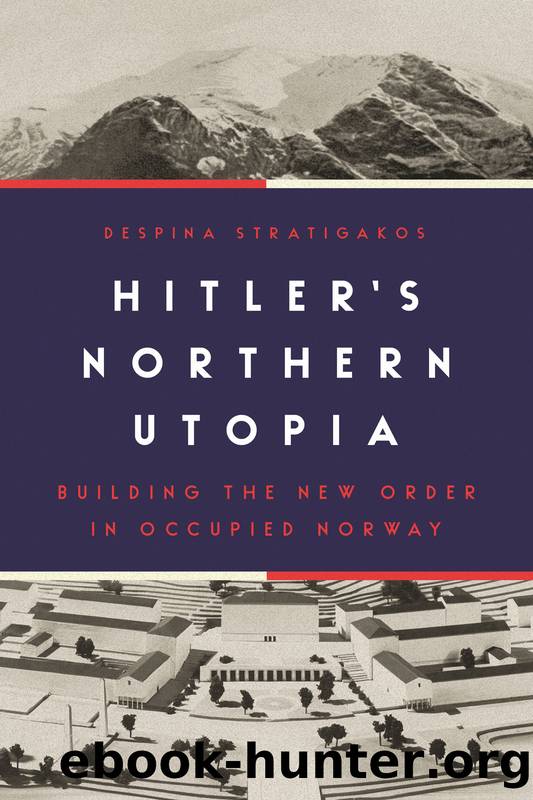Hitler's Northern Utopia by Despina Stratigakos

Author:Despina Stratigakos
Language: eng
Format: epub
Publisher: Princeton University Press
Published: 2020-06-04T00:00:00+00:00
4.26. Illustration accompanying an article, “Three Cities,” by architect Per Pihl (later chief planner in Drammen) that appeared in the 1945 Byggekunst issue evaluating BSR plans. Based on the BSR’s plan for Namsos, Pihl imagined three scenarios: the militaristic conformity of a Nazi-approved BSR plan in 1; the anarchic result of too little central control in 2; and an ideal mixture of central planning, private initiative, and mixed-use spaces (domestic, commercial, and light industrial) in 3.
Despite vociferous criticisms, the BSR plans developed under Nazi supervision were, with minor modifications, constructed after the war.151 The fact that the streets had already been laid out contributed significantly to this outcome. More broadly, the costs and delays involved to begin anew were simply too great, especially at a time of desperate need. Hitler’s scorched-earth campaign in northern Norway meant that, in addition to the war damage that still needed to be addressed from the 1940 invasion, whole swaths of northern Norway also needed to be rebuilt, necessitating an enormous expenditure of resources and architectural expertise. Many BSR architects therefore went north, to restore the towns that had been burned and razed in the winter of 1944–45 by Hitler’s retreating troops.152
The most substantial changes to the BSR plans occurred perforce, with the destruction of the Greater German Reich and its ideological apparatus: buildings intended as linchpins in the creation of ideal National Socialist communities, such as the Parteihaus and Reichshaus, were reassigned democratic or commercial functions. On the level of design, attempts to modulate the authoritarian sensibilities denounced by the Byggekunst critics focused largely on aesthetic interventions.153 In Molde, for example, architects again embraced modernist styles and materials; on Storgata, they pulled some buildings back from the street and varied their rooflines to relax the impression of uniform building blocks standing at attention. Molde historian Olav Arild Abrahamsen has called this process a washing off of the town’s “German cosmetics.” The fundamental elements of Pedersen’s vision remained and even enjoyed local support. Molde authorities who had worked with Pedersen in the mid-1930s and appreciated the similarities to that earlier proposal were far more positive than the Byggekunst critics about his BSR plan.154
In 1980, the editors of Byggekunst reevaluated the BSR reconstruction plans. They placed many of the elements that had been condemned as National Socialist, such as the axiality and symmetry of the plans, in the context of broader Norwegian and European traditions. They also drew attention to continuities with Pedersen’s prewar ideals. The editors acknowledged that the Germans’ preference for Pedersen’s style did not make it fascist; indeed, they concluded that the BSR designs were “Norwegian until the Germans blessed them.” Architect Unnleiv Bergsgard, writing in Byggekunst on the 1982 centennial of Pedersen’s birth, admitted that functionalist architects of his generation had welcomed Edvard Heiberg’s strong criticisms as a reaction against Pedersen’s hegemonic position in Norwegian town planning. Heiberg’s disgust also resonated with their antipathy to Pedersen’s architectural values, which Bergsgard and his peers had rejected after the war. In the 1980s, when the tide of criticism turned against postwar functionalism, Pedersen’s work did not seem so bad.
Download
This site does not store any files on its server. We only index and link to content provided by other sites. Please contact the content providers to delete copyright contents if any and email us, we'll remove relevant links or contents immediately.
Magic and Divination in Early Islam by Emilie Savage-Smith;(1500)
Ambition and Desire: The Dangerous Life of Josephine Bonaparte by Kate Williams(1344)
Bohemians, Bootleggers, Flappers, and Swells: The Best of Early Vanity Fair by Bohemians Bootleggers Flappers & Swells- The Best of Early Vanity Fair (epub)(1343)
Papillon by Henry Charrière(1309)
Twelve Caesars by Mary Beard(1256)
Operation Vengeance: The Astonishing Aerial Ambush That Changed World War II by Dan Hampton(1134)
What Really Happened: The Death of Hitler by Robert J. Hutchinson(1128)
London in the Twentieth Century by Jerry White(1112)
Time of the Magicians by Wolfram Eilenberger(1087)
The Japanese by Christopher Harding(1086)
Twilight of the Gods by Ian W. Toll(1084)
Lenin: A Biography by Robert Service(1043)
The Devil You Know by Charles M. Blow(985)
A Social History of the Media by Peter Burke & Peter Burke(936)
Freemasons for Dummies by Hodapp Christopher;(922)
Napolean Hill Collection by Napoleon Hill(902)
Henry III by David Carpenter;(891)
The Churchill Complex by Ian Buruma(881)
The Rise and Triumph of the Modern Self by Unknown(877)
